The continent of Africa has many wonders, not least of which is its fantastic wildlife. One type of fish that is particularly popular among aquarium enthusiasts is the African cichlid. These colorful and often aggressive fish are native to Africa’s many freshwater lakes, rivers, and streams.
There are over 1300 scientifically-described types of African cichlids today, and new ones are being discovered all the time. Some popular species have been introduced to the aquarium trade for years, while others are still relatively new to the hobby.
With so many kinds of African Cichlids available, it can be overwhelming for hobbyists to decide which ones they want to keep in their tanks. In this article, we’ll look at some of the most popular African cichlid species and offer some tips on choosing the right ones for your aquarium!
Lake Malawi Cichlid
Lake Malawi is one of the major Rift Valley lakes in Africa. The streams and rivers that flow into this lake have high mineral content. The less rainfall and increased evaporation result in highly mineralized alkaline and hard water as the climate changes.
The clarity and stability of water in Lake Malawi make it an excellent biologically diverse natural habitat for a vast number of Cichlids. These Lake Malawi Cichlids are divided into three ecological groups: Haplochromis(Haps), Aulonocara Cichlids (Peacock), and the Mbunas.
Mbuna Groups: Top 10 Species
The Mbuna are a group of rock-dwelling cichlids that live among the rocky areas along the shores of Lake Malawi. The word “Mbuna” means “rockfish” in the local Tonga language, and these fish are well-adapted to life among the rocks.
Mbuna cichlids are some of the most popular freshwater fish in the aquarium trade due to their bright colors and active personalities. But beware – these fish are also highly territorial. Get things wrong, and you could end up with a bloodbath on your hands.
Here are the most thought-after in the aquarium community.
Yellow Lab Cichlid (Labidochromis caeruleus)

This species is known for its vibrant electric yellow coloration. The notable black stripe can be found on its dorsal fins and anal fins when reaching full maturity. Several color variations are available, and the strikingly yellow is just one variety.
Most Mbunas are known for their aggression, but the Yellow Lab Cichlid is among the most peaceful Mbuna, making them the best fish for Mbuna beginners.
| Scientific Name: | Labidochromis caeruleus |
| Common Name: | Electric Yellow Lab, Yellow Labido, Lemon Yellow Lab, and Lemon drop Cichlid |
| Size: | 3.2 inches (8.10 cm) |
| Diet: | Omnivore |
| Minimum Tank Size: | 30 Gallons |
Bumblebee cichlid (Pseudotropheus crabro)
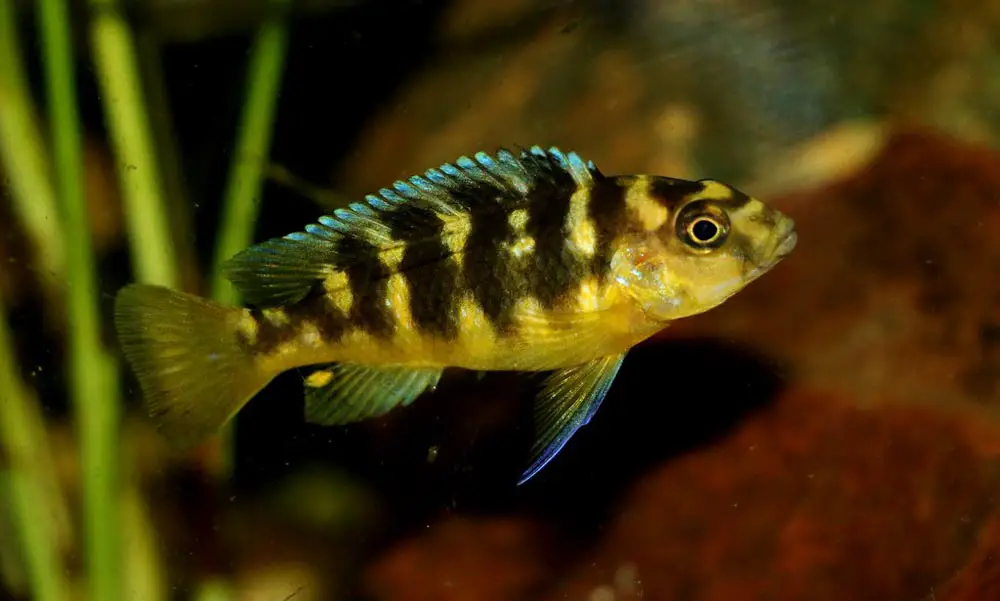
There’s no denying that the Bumblebee cichlid is a pretty fish. Its common name tells you everything you need to know about its appearance, with its yellow and black stripes resembling that of a bumblebee. Additionally, it can change color to almost black very rapidly depending on mood and stress levels.
| Scientific Name: | Pseudotropheus crabro |
| Common Name: | Bumblebee Cichlid, Hornet cichlid |
| Size: | 6.3 inches (16 cm) |
| Diet: | Omnivore |
| Minimum Tank Size: | 75 Gallons |
Saulosi Cichlid (Pseudotropheus saulosi)
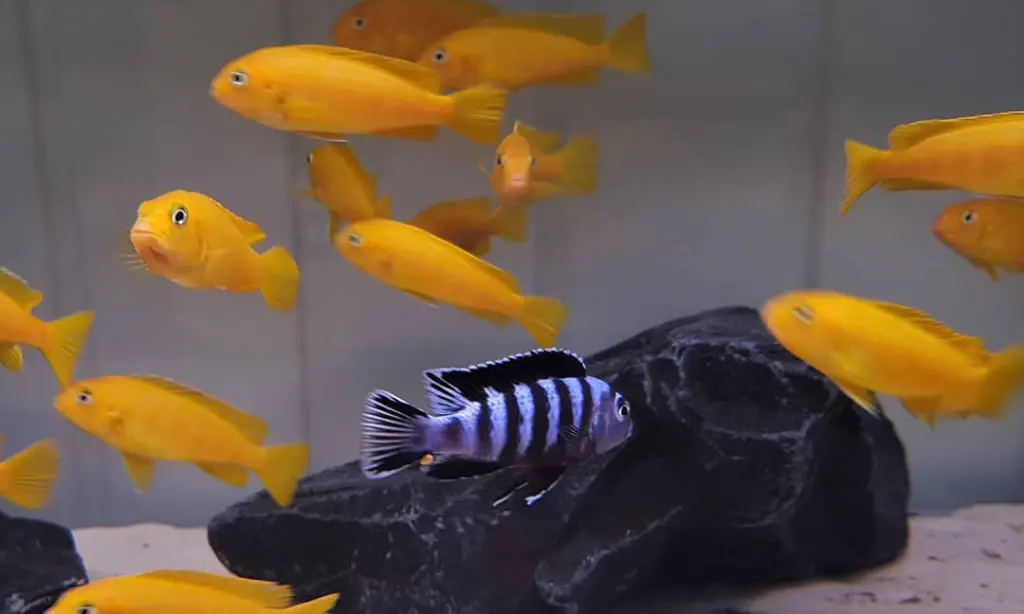
Saulosi cichlids are a delightful addition to mbuna aquariums. These little fish are a joy to keep and breed, and their vibrant colors and personalities make them a favorite among many aquarists.
It’s referred to as a dwarf Cichlid, reaching a maximum size of only 3.4 inches (8.6 cm). The dominant male is typically more colorful, with several vertical black stripes running down their body. Females are also beautiful, covered with deep yellow. Interestingly, fry is born with a yellow body.
Despite their small size, Saulosi cichlids are very aggressive and territorial and need a lot of swimming space.
| Scientific Name: | Pseudotropheus saulosi |
| Common Name: | Saulosi Cichlid |
| Size: | 3.4 inches (8.6 cm) |
| Diet: | Omnivore |
| Minimum Tank Size: | 55 Gallons |
Demasoni Cichlid (Pseudotropheus demasoni)

With its curious nature and bright colors, and attractive patterning, Demasoni Cichlid is becoming a very popular aquarium fish. Like most Mbunas, it has an elongated ‘torpedo’ body shape, with vertical bars all over. There is also a dark stripe running across the forehead.
It’s smaller than Saulosi Cichlid, classified as a ‘dwarf’ category due to its size. But, they have the same level of aggression. Only recommended for the intermediate and experienced cichlid keeper.
| Scientific Name: | Pseudotropheus demasoni |
| Common Name: | Demasoni Cichlid |
| Size: | 3 inches (7.5 cm) |
| Diet: | Omnivorous |
| Minimum Tank Size: | 55 Gallons |
Electric Blue Mbuna (Pseudotropheus johannii)
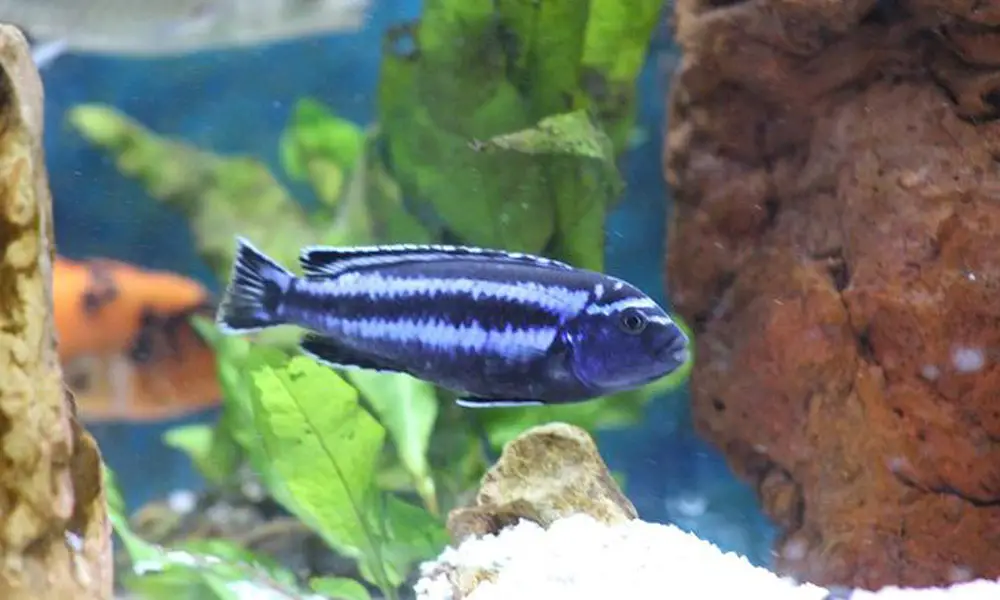
The Electric Blue Mbuna (Pseudotropheus johannii) has many common names, including Johanni Cichlid, Blue Johanni, Bluegray Mbuna, and the Electric Blue Johanni.
This species is sexually dimorphic, males are primarily brilliant blue with a black horizontal band, but it will likely bleed onto light blue, forming a checkerboard patterning on the body. Juvenile resembles the females in mostly bright yellow-orange.
Because of its common name, “Electric Blue,” this species is always confused with the Electric Blue Hap (Sciaenochromis fryeri), which is a totally different species that belongs to the Haplochromis (Haps) Group.
These fish are also small fish that only reach a maximum length of about 3″ (7.5 cm) in length, but like their close relatives, they are known to be very aggressive.
| Scientific Name: | Pseudotropheus johannii |
| Common Name: | Electric Blue Mbuna, Johanni Cichlid, Blue Johanni, Bluegray Mbuna, Blue Mbuna |
| Size: | 3.0 inches (7.49 cm) |
| Diet: | Omnivorous |
| Minimum Tank Size: | 55 Gallons |
Acei Cichlid (Pseudotropheus Acei)
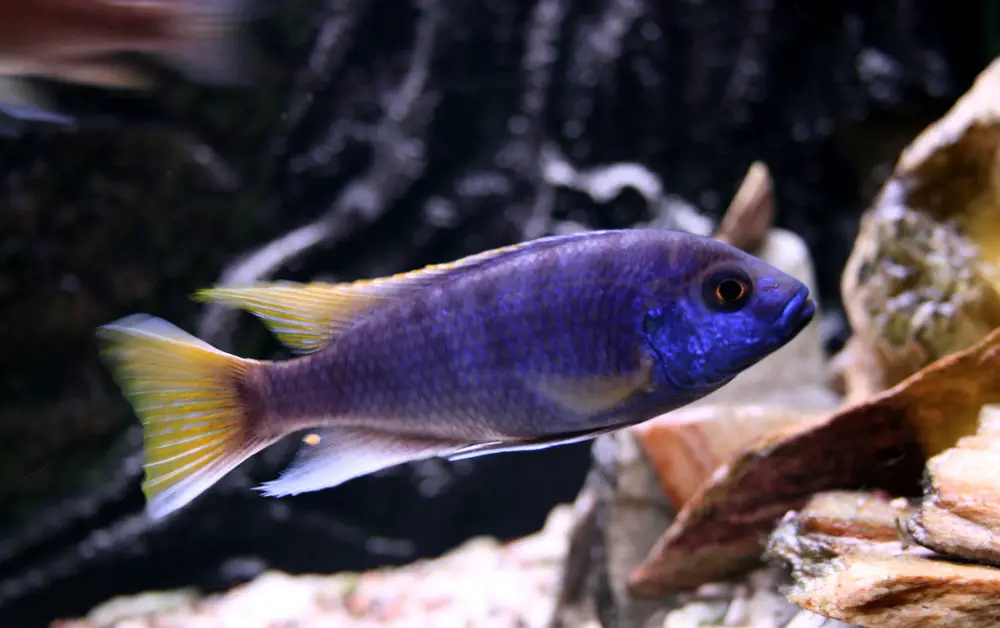
Another beauty from the genus Pseudotropheus. Acei Cichlids sometimes referred to as yellow-tail acei, are a long-time favorite of African Cichlids enthusiasts, thanks to their bright blue and yellow coloration and interesting banded markings on their fins and bodies.
Two varieties are available, including the most common yellow-tailed Pseudotropheus sp. “acei” (Msuli) and the white-tail variant, Pseudotropheus sp. “acei” (Ngara).
Although this fish has been introduced to the aquarium trade for many years, it has not been formally described.
| Scientific Name: | Pseudotropheus Acei |
| Common Name: | Acei Cichlid |
| Size: | 6 inches (15.2 cm) |
| Diet: | Herbivore |
| Minimum Tank Size: | 55 Gallons |
Red Zebra Cichlid (Maylandia estherae)

The Red Zebra (Maylandia estherae) is one of the most commonly kept of the Mbuna! They have a very appealing coloration and outgoing personalities.
This fish does not have these prominent stripes like many other close relatives in this genus. But, like other Mbuna, there are many different color morphs available. In the wild, males are bright blue, while females can range from brown to brilliant red, almost looking like two separate species.
| Scientific Name: | Maylandia estherae |
| Common Name: | Red Zebra Cichlid |
| Size: | 5.0 inches (12.7 cm) |
| Diet: | Omnivorous |
| Minimum Tank Size: | 55 Gallons |
Dogtooth Cichlid (Cynotilapia afra)

For years, dogtooth cichlids have been a favorite among many aquarists because of their beautiful color patterns. The name “Dogtooth” comes from the fact that they have sharp, conical unicuspid teeth rather than the bicuspid teeth found in most other cichlids of similar size.
Several different color varieties are available, mixing with lavender, blue, and yellow in between. Generally, the males are bright blue with 7 dark black vertical bands on their bodies. Females are mostly blue-gray to slate gray.
| Scientific Name: | Cynotilapia afra |
| Common Name: | Dogtooth Cichlid |
| Size: | 4 inches (10 cm) |
| Diet: | Omnivorous |
| Minimum Tank Size: | 55 Gallons |
Kenyi Cichlid (Maylandia lombardoi)
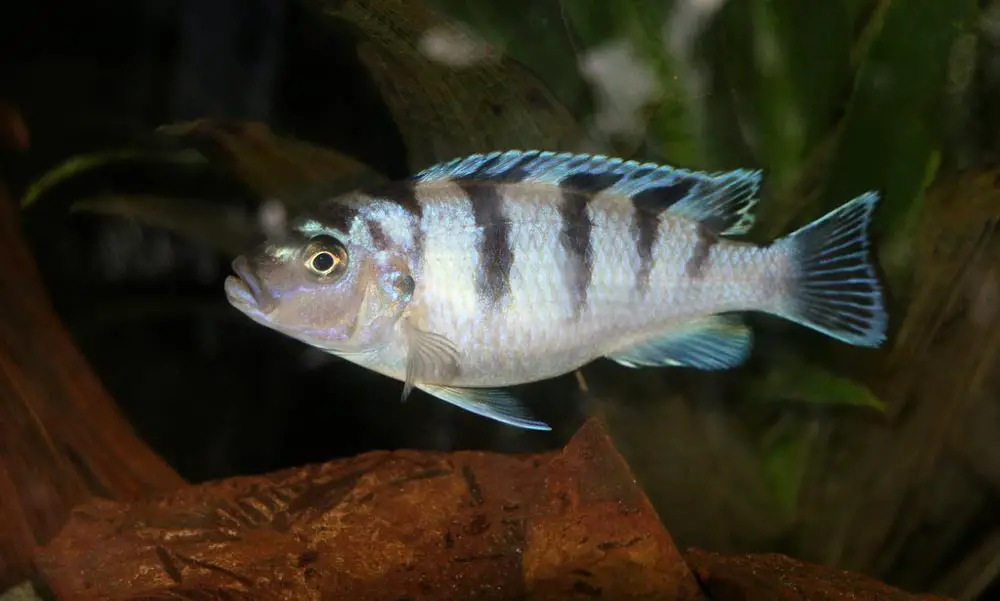
Kenyi Cichlids (Maylandia lombardoi) sport a unique zebra-barred look, making them a very popular Mbuna out there. The species is highly sexually dimorphic, with the males having a bright orange/yellow body with faint brown bars crossing the body. On the other hand, females are pale white-blue with some horizontal blue-black bars extending onto the dorsal fin.
| Scientific Name: | Maylandia lombardoi |
| Common Name: | Lombardoi Cichlid, Kennyi Cichlid, Blue Kenyi Cichlid |
| Size: | 5.0 inches (12.70 cm) |
| Diet: | Omnivorous |
| Minimum Tank Size: | 55 Gallons |
Fairy Cichlid (Aulonocara jacobfreibergi)

While Mbunas are known for their beautiful coloration and patterning, the Fairy Cichlid (Aulonocara jacobfreibergi) shines in its own right with its striking body coloration and elegant fins.
Often referred to as African Butterfly Cichlids, they do deserve this name in any aquarium because of their peaceful demeanor and beautiful colors.
Several color morphs are available, with blues, reds, and yellows. Adult males are easily distinguished from females by their bright body coloration with broad, iridescent, white dorsal and caudal fins, while females are drab white to grayish-brown color, with faded colored vertical bands.
| Scientific Name: | Aulonocara jacobfreibergi |
| Common Name: | Fairy Cichlid |
| Size: | 8 inches (20 cm) |
| Diet: | Omnivorous |
| Minimum Tank Size: | 55 Gallons |
Aulonocara Cichlids (Peacock)
Aulonocara is a genus of haplochromine cichlids, currently containing 22 recognized species. These species are some of the most beautiful African cichlids in the world. Their stunning colors brilliantly cast in blues, reds, and yellows, are simply breathtaking. It’s no wonder these stunning cichlids are known as peacock cichlids among aquarium enthusiasts.
These vibrant fish come in a wide range of colors and patterns and can be divided into two groups: the Hybrid Peacocks and the Species Peacocks.
Hybrid Peacocks Cichlids
Here are some sought-after hybrid peacocks in the aquarium trade:
- OB Peacock
- Dragon Blood Peacock Cichlid
- Flametail Peacock
- Strawberry Peacock Cichlid
Species Peacocks Cichlids
Compared with Hybrid Peacocks, species peacocks are less showy in colors, but they are more peaceful. Nevertheless, many hobbyists still love to keep them because of their unique pattern and coloration.
Some popular peacock cichlids include:
- Aulonocara nyassae (Emperor Cichlid)
- Aulonocara jacobfreibergi (Freiberg’s peacock)
- Aulonocara stuartgranti (Flavescent peacock)
- Aulonocara kandeense (Blue orchid aulonacara)
Haplochromis(Haps) Groups
Scientifically speaking, there are no true Haplochromis species in the group of Malawi cichlids “Haplochromis.” In fact, they are found in Lake Victoria, not lake Malawi. Today, as more research was made by the scientists, all Malawi cichlids once counted as part of this group have been classified into other genera. However, their original genus name has remained among aquarium enthusiasts.
As the largest group in the Cichlidae family, this genus currently has 229 recognized species. The haps cichlids are ray-finned fish, a model for evolutionary processes.
Most haps members are generally larger than the Mbuna cichlids. They prefer sandy and open water habitats.
There are three subgroups of Haplochromis species found in Lake Malawi:
Utaka Cichlids
The Utaka Cichlids (called by the fishermen in Malawi on their boats) are found in schools in the open water regions but prefer to stay close by on cliffs. Utaka Cichlids can be found in two genera, including
- Copadichromis
- Mchenga
Not all Utaka Cichlids can be found in the hobby, especially the Mchenga species. Some of these fish are quite large and only suitable for professional aquariums or researchers with tanks that can hold them comfortably. Unlike Mauna, Utaka tends to be very neutral in color until they reach adulthood.
When it comes to keeping Utaka cichlids in an aquarium, you’ll want some peace-loving Mbuna. Be careful when mixing different Utaka species together, resulting in crossbreeding.
Utaka species are mouth breeders, but there is a diverse group with many different behaviors when it comes to breeding. Some are seasonal breeders, while others can produce offspring year-round, and yet another group prefers cliffs as their spawning sites.
There are 31 described species in this group, but only three Copadichromis are commonly found in the aquarium hobby today.
Copadichromis borleyi (Redfin Hap)
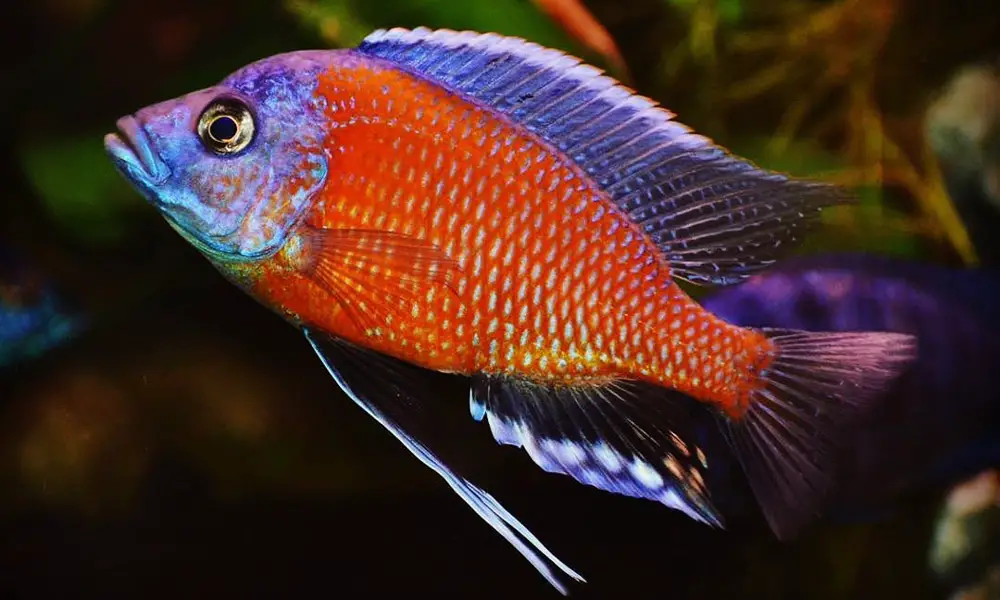
Redfin hap is a gorgeous hap that sports a unique look. This beautiful fish earned its common name from the fact that females and juveniles will mostly sport red/orange fins with grayish bodies. Males are brightly colored with a royal orange body and shiny blue faces.
This fish is one of the largest and fast-growing Utaka species. You can keep multiple males and females in school together when they are not spawning.
| Scientific Name: | Copadichromis borleyi |
| Common Name: | Redfin Hap |
| Size: | 5.5 inches (14 cm) |
| Diet: | Omnivorous |
| Minimum Tank Size: | 75 Gallons |
Copadichromis azureus (Azureus Cichlid)
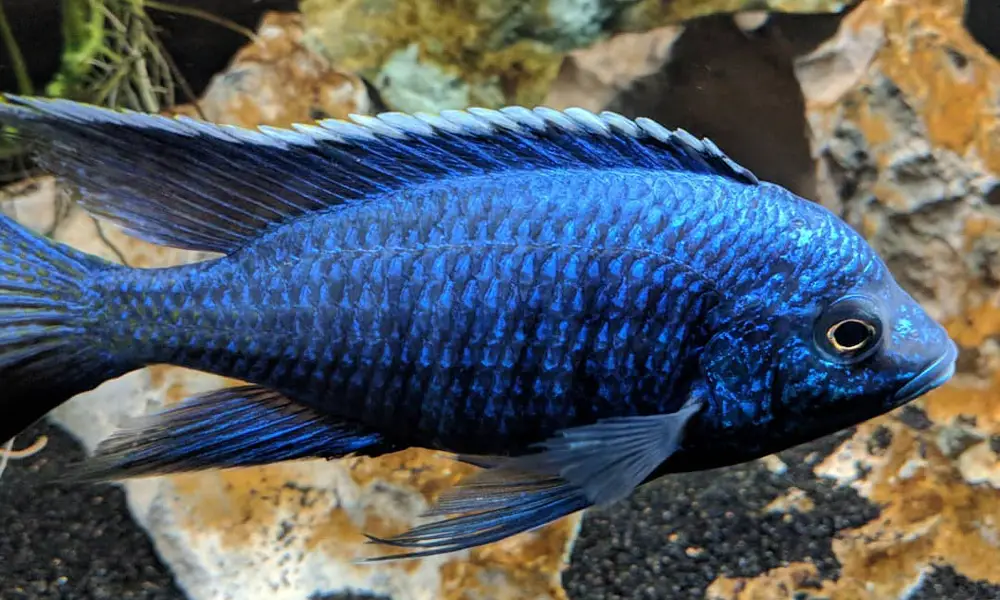
Looking for a relatively peaceful Hap? Then the Azureus Hap is perfect for you! These gorgeous fish are known to be one of the more peaceful members of the Copadichromis genus and make a great addition to any Haps tank.
Males of this species will develop an azure blue body with white spots as they mature, while females usually stay gray with three black dots typical of Copadichromis species.
| Scientific Name: | Copadichromis azureus |
| Common Name: | Azureus Cichlid |
| Size: | 7 inches (17.8 cm) |
| Diet: | Carnivore |
| Minimum Tank Size: | 75 Gallons |
Copadichromis chrysonotus (White Blaze)
The White Blaze is the only known species to spawn in open water in this genus, while others are sand burrowers. Another difference is this species inhabits with other utaka in quite deep, open water.
As its name suggests, the C. chrysonotus have a white blaze. Males develop sooty black lower fins and whitish dorsal fins. The primary color of males is faded from black to light blue. Females remain gray with three black spots on the body, and the caudal fin is yellow.
| Scientific Name: | Copadichromis chrysonotus |
| Common Name: | White Blaze |
| Size: | 6.2 inches (16 cm) |
| Diet: | Omnivore |
| Minimum Tank Size: | 55 Gallons |
The Predatory “Haps”
The second group is called predatory “Haps.” These large and colored cichlids prey on other Malawi cichlids.
Like the Utaka species, they are not limited to any particular biotope. They don’t usually stake out territories and stay put; instead of holding on to their homes by finding cracks or crevices, they’re more transient when it comes to food.
Most Predatory Haplochromis cichlids from Lake Malawi need a large aquarium to live. It’s best to have several females together, while two or several males will fight each other to the death.
Never keep smaller fish with Predatory Haplochromis cichlids, as they will be eaten sooner or later. I would recommend keeping only one “hap” in a community tank.
Sometimes, though, the predatory haps can get along with Mbuna cichlids in an aquarium with plenty of hiding places and natural borders so that each fish can stay away from each other’s sight.
They are also mouthbrooders; the number of eggs per clutch depends on the species and female size. For those who want to own a predatory hap, check out the species from the following genera.
- Aristochromis
- Buccochromis
- Champsochromis
- Dimidiochromis
- Exochochromis
- Hemitaeniochromis
- Lichnochromis
- Naevochromis
- Nimbochromis
- Tyrannochromis
- Taenochromis
- Stigmatochromis
While there are lots of predatory “Haps,” several definitely stand out with their bright colors and hunting skills. Here’s a list of some of the most popular:
Aristochromis christyi (Malawi Hawk Cichlid)
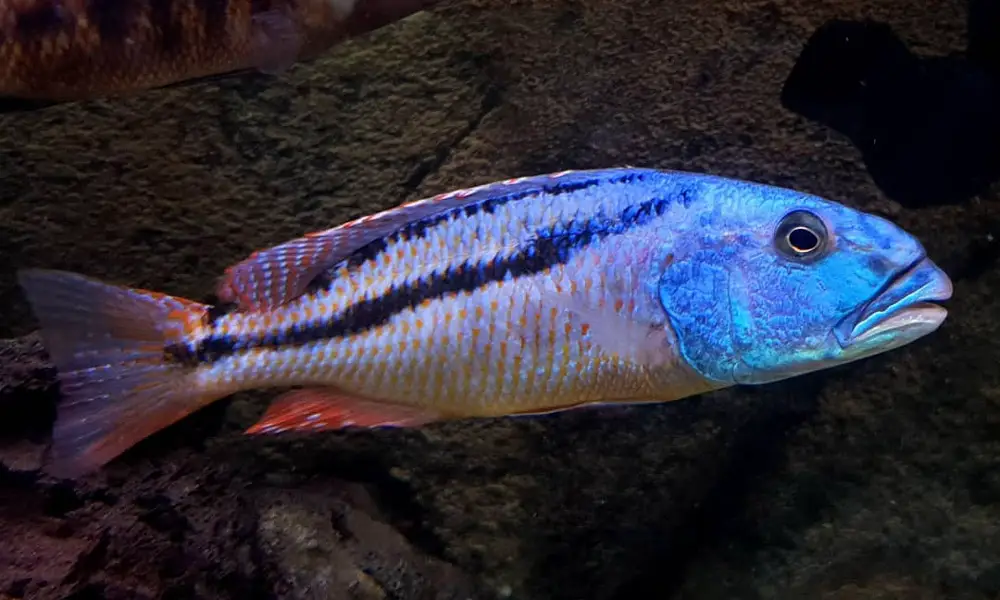
Aristochromis christyi, also known as Malawi Hawk, is the only known species of its genus. This unique predator gets its common name from the beak-like mouth used to snatch up its unsuspecting prey.
Like most predatory “Haps,” it has an elongated body with a bulbous head. Females and juveniles have a silvery base with a prominent horizontal black bar that runs along the back.
As males get older, those black bands will slowly disappear and be replaced by an electric blue color. When they are ready to spawn, the male’s ventral fins change to orange, becoming one of the most stunning African cichlids and an actual centerpiece fish for your aquarium.
| Scientific Name: | Aristochromis christyi |
| Common Name: | Malawi Hawk Cichlid |
| Size: | 10 inches (25 cm) |
| Diet: | Carnivora |
| Minimum Tank Size: | 125 Gallons |
Buccochromis nototaenia (Stripeback Hap)
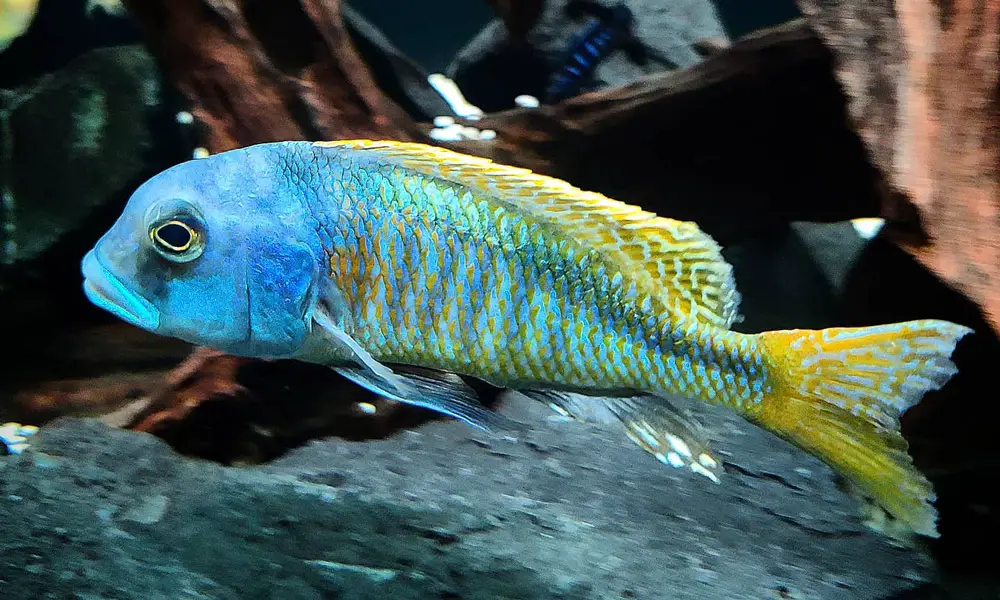
The appearance and activity levels have made Stripeback Haps very appealing among aquarists in recent years. In Lake Malawi, these fish are exclusively endemic to waters off the shorelines. Females are not as colorful as males, but they still have a primarily silver base with a diagonal stripe. You also see a yellow hue on the snout, ventral, anal, and tail fins.
| Scientific Name: | Buccochromis nototaenia |
| Common Name: | Stripeback Hap, Bucco Noto |
| Size: | 9 inches (22.5 cm) |
| Diet: | Carnivora |
| Minimum Tank Size: | 125 Gallons |
Nimbochromis livingstonii (Livingstoni Cichlid)

The Livingstoni Cichlid (Nimbochromis livingstonii) is a large handsome hap. These fish have prominent dark sports sit on a yellow, silver, or blue base, creating intense contrast. You might also see a “star” pattern around the eyes, formed by four dark lines. What’s more, this interesting camouflaged “giraffe spot” pattern can rapidly change to solid dark blue all over when they prey on smaller fishes.
| Scientific Name: | Nimbochromis livingstonii |
| Common Name: | Livingstoni Cichlid |
| Size: | 10 inches (25 cm) |
| Diet: | Carnivora |
| Minimum Tank Size: | 125 Gallons |
Tyrannochromis macrostoma (Big-Mouth Hap)

T. macrostoma is one of the well-known Haps belonging to the small genus Tyrannochromis with only four described species. Thanks to their distinct looks and fierce behavior, these predators are popular in the aquarium trade. Of course, the most prominent feature of this hap is its large mouth.
| Scientific Name: | Tyrannochromis macrostoma |
| Common Name: | Big Mouth Hap Cichlid |
| Size: | 14 inches (35 cm) |
| Diet: | Carnivora |
| Minimum Tank Size: | 180 Gallons |
Other Malawi “Haps”
When it comes to the Malawi Haps, a third group is often overlooked. This group, known as the Other Haps, is quite diverse since it includes all the Malawi Haps that don’t fit into the other two groups (Utaka and Predatory Haps).
These fish are a diverse bunch, including herbivores and insect eaters. They’re generally happy eaters in aquariums, although you should supplement their diet with similar food types to what they would eat in the wild.
- Cheilochromis
- Chilotilapia
- Cyrtocara
- Ctenopharynx
- Fossorochromis
- Hemitaeniochromis
- Hemitilapia
- Mylochromis
- Otopharynx
- Placidochromis
- Protomelas
- Sciaenochromis
- Taeniochromis
- Tramitichromis
These Haps come with a wide variety of feeding behaviors, so you’ll need to research each one before adding it to your aquarium.
Cyrtocara moorii (Blue Dolphin Cichlid)
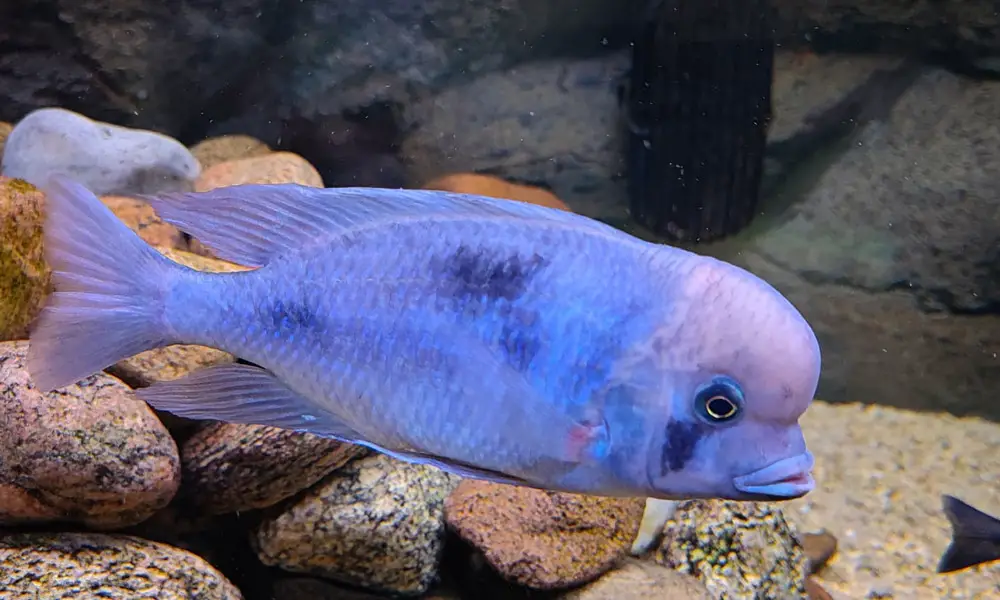
An exotic and relatively peaceful species, the Blue Dolphin Cichlid (Cyrtocara moorii) is named for its nuchal hump and bottle-nose mouth that cause it to resemble a dolphin. It’s one of the most popular cichlids in the aquarium trade due to its vibrant coloration and relatively docile nature.
| Scientific Name: | Cyrtocara moorii |
| Common Name: | Blue Dolphin Cichlid, Malawi Blue Dolphin Cichlid, Hump-head |
| Size: | 9.8 inches (24.99 cm) |
| Diet: | Carnivorous |
| Minimum Tank Size: | 75 Gallons |
Fossorochromis rostratus (Tampa Bay Cichlid)
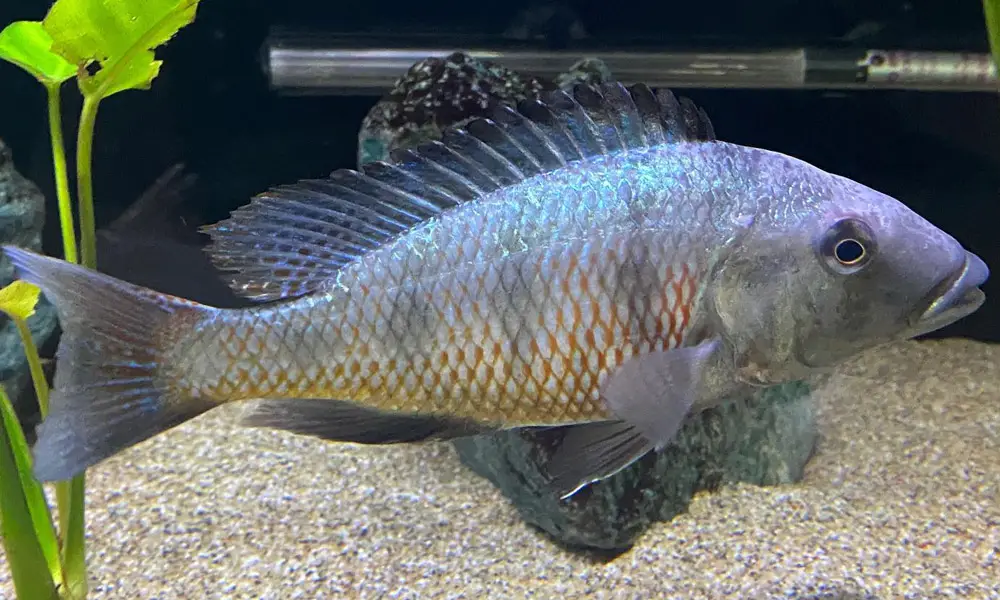
Sometimes referred to as Tampa Bay Cichlids, the Fossorochromis rostratus is also the only member in its genus. In the wild, they are found in groups of at least 50 individuals, with only one male showing dominant coloration. The dominant males will have a blue body with black vertical stripes, while the females and subdominant males are drabber in coloration.
A soft sandy substrate is ideal for this fish since it spends a lot of time digging and sifting through the sand in search of microorganisms.
| Scientific Name: | Fossorochromis rostratus |
| Common Name: | Tampa Bay Cichlid |
| Size: | 10″ (25 cm) |
| Diet: | Carnivore |
| Minimum Tank Size: | 125 Gallons |
Otopharynx lithobates (z rock cichlid)
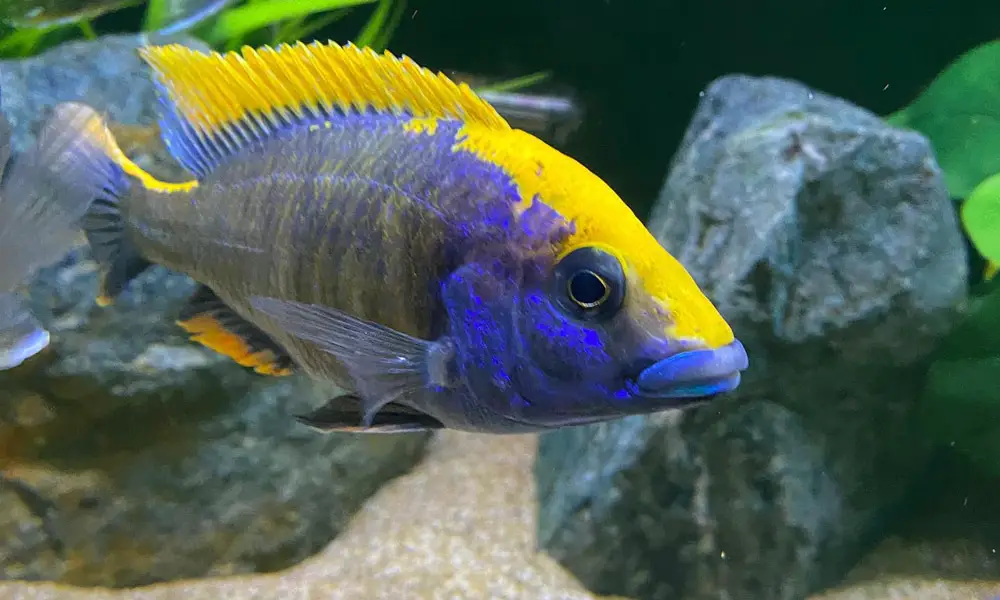
Z-rock cichlids (Otopharynx lithobates) are a stunning Haplochromis that can add a splash of color to your tank. They inhabit among the rocks and large caves, so you’ll want to provide plenty of hiding spots in your aquarium.
Males have a distinct appearance. They have a bright blue body with a signature “blaze” along their back, while females exhibit silver shades supported by black dots.
| Scientific Name: | Otopharynx lithobates |
| Common Name: | Z-rock Cichlid, Sulphur-headed Hap, Zimbawe Rock |
| Size: | 6.4″ (16 cm) |
| Diet: | Carnivore |
| Minimum Tank Size: | 75 Gallons |
Placidochromis sp. “Phenochilus Tanzania” (star sapphire cichlid)
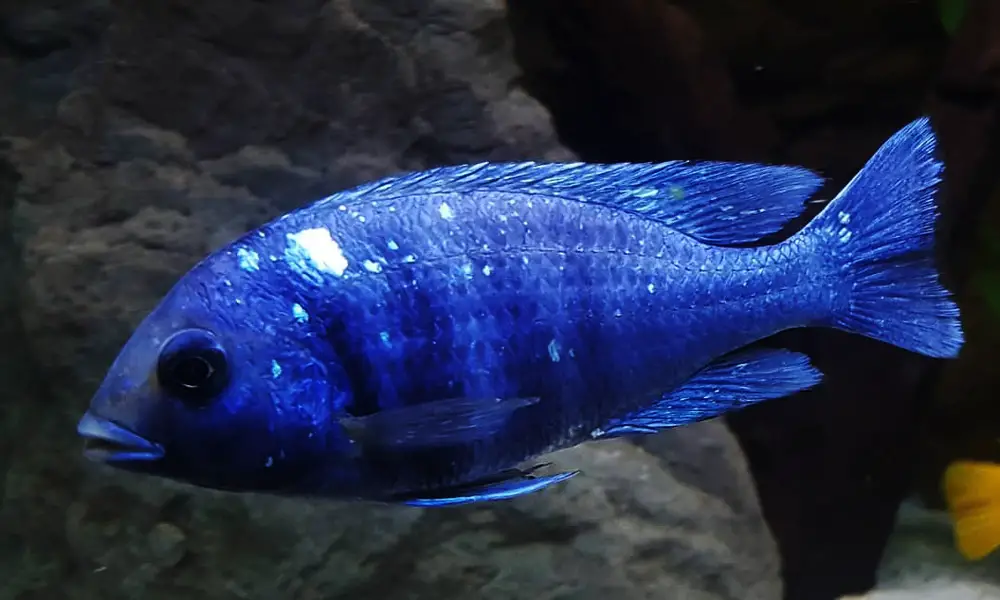
Because of their appearance, the Star sapphire cichlid (Placidochromis sp. “Phenochilus Tanzania”) has gotten a lot of attention from the Malawi cichlids hobbyists. The unique name matches its appearance perfectly with a gorgeous metallic blue body covered with sparkles, exhibiting an elegant constellation engraved in a sapphire.
You need patience as they start their true colors at around 3 inches.
| Scientific Name: | Placidochromis sp. “Phenochilus Tanzania” |
| Common Name: | Star Sapphire Cichlid |
| Size: | 10 inches (25.4 cm) |
| Diet: | Carnivore |
| Minimum Tank Size: | 125 Gallons |
Protomelas taeniolatus (Red Empress Cichlid)
The Red Empress (Protomelas taeniolatus) is a truly breathtaking species. For years, this fish has been one of the most popular cichlids in the aquarium trade.
Like many other Haps, the red empress can come in a wide variety of color morphs that vary based on location. The males have a reddish-orange body with distinct electric yellow, red, and brown markings. On the other hand, females typically do not exhibit bright coloration, taking on a light gray body with two horizontal lines.
Not only that but these fish are also known to be easy to take care of and have a relatively peaceful temperament.
| Scientific Name: | Protomelas taeniolatus |
| Common Name: | Red Empress Cichlid |
| Size: | 8 inches (20 cm) |
| Diet: | Omnivore |
| Minimum Tank Size: | 125 Gallons |
Sciaenochromis fryeri (Electric Blue Hap)
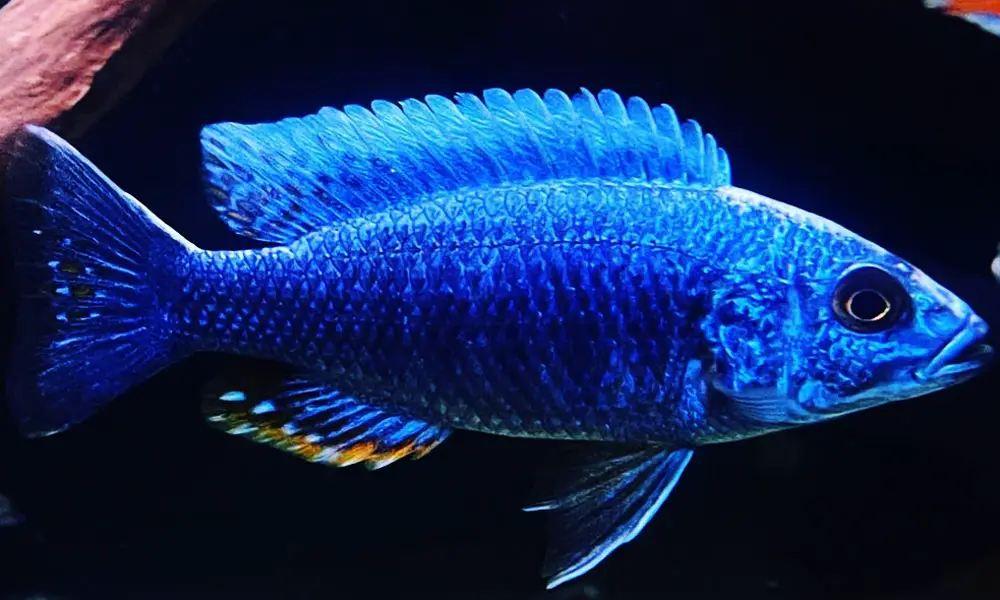
We have mentioned this species earlier. Sciaenochromis fryeri is commonly called “Electric Blue Hap” or “Electric Blue,” an old favorite with Malawi cichlid enthusiasts.
This fish is sexual dimorphism. Males boast a strikingly intense metallic blue base and have red and orange accents on their fins. Sometimes, you may notice a white band that extends to its head. The females, however, are brownish-grey to silver and vary from different collection locations.
| Scientific Name: | Sciaenochromis fryeri |
| Common Name: | Electric Blue Hap |
| Size: | 8 inches (20 cm) |
| Diet: | Omnivore |
| Minimum Tank Size: | 125 Gallons |
Lake Tanganyika Cichlids
Lake Tanganyika is the longest lake in the world. It’s home to two record-breaking inhabitants; the world’s largest cichlid fish, which can reach 31 inches in length, as well as the smallest one at only 1 inch long!
Over 250 species of cichlid fish are endemic to the lake, and undescribed ones remain. Tanganyika lake has many attractive cichlid fish.
Most Tanganyika Cichlids are slow-growing, and species from the Tropheus groups are extremely sensitive to water parameter changes and do not appreciate large water changes. A good rule is to change 10 to 15 percent of the water weekly.
Here is an alphabetical checklist of all scientifically described Lake Tanganyika Cichlids genera and species.
Lake Victoria Cichlids
Lake Victoria is the world’s second-largest freshwater lake by surface area. It is also Africa’s largest lake and is home to over 500 species of cichlid fish, most of which are endemic.
Unlike Lake Malawi and Lake Tanganyika, Lake Victoria is not a rift lake, and most of these lakes are relatively shallow. The vast majority of these species are found in the shallowest parts of the lake (less than 20 meters deep), where there is abundant food and shelter.
The majority of Victoria’s cichlids are herbivores, feeding on algae, plants, and invertebrates. However, there are a few exceptions.
Lake Victoria Cichlids kept by hobbyists include species from these genera:
- Astatotilapia
- Haplochromis
- Mbipia
- Neochromis
- Paralabidochromis
- Ptyochromis
- Platytaeniodus
- Pundamilia
- Pseudocrenilabrus
Although the number of species sounds daunting, only one percent of fish caught in Lake Victoria comes from cichlids. More than half of the cichlid species have been listed by IUCN as threatened or extinct due to overfishing and habitat loss.
Only a handful are popular among aquarists. The most popular species include:
Pundamilia nyererei (Pundamilia nyererei Cichlid)
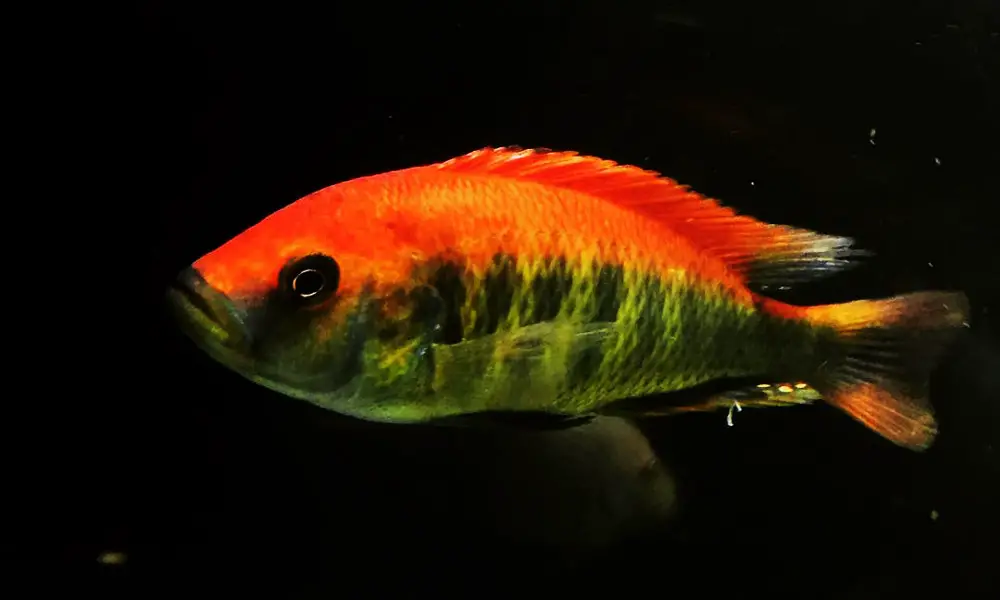
The Pundamilia nyererei Cichlid (Pundamilia nyererei) is a popular Lake Victoria species that lives up to the hype.
The base color of males is usually red in the upper body and yellow-green in the lower part of the body, covered with black stripes throughout. Typically females are mostly gray with a yellow hue in the fins.
| Scientific Name: | Pundamilia nyererei |
| Common Name: | Pundamilia nyererei Cichlid |
| Max Size: | 5 inches (12.7 cm) |
| Diet: | Carnivore |
| Minimum Tank Size: | 75 Gallons |
East African Cichlids
Besides the well-known Lake Malawi, Lake Tanganyika, and Lake Victoria cichlids, you will run through many fascinating African cichlids.
These East African Cichlids include those from lakes surrounding Lake Victoria. Some tend to be found in the African rivers and streams, where they adapted to the different habits.
Additionally, many species are from remote inhabited islands located off the eastern coast of Africa, like dominant Madagascar and several smaller islands.
These cichlids include species from the following genera:
- Astatoreochromis
- Astatotilapia
- Lithochromis
West African Cichlids
West African cichlids come in a wide variety of shapes, colors, and sizes and come from the African rivers and streams along the coastal zones where they occupy a diversity of habitats.
With so many vibrant species out there, African dwarf cichlids are not to be missed for anyone who wants to set up an exciting and unique freshwater aquarium at home.
Unfortunately, these little gems are highly aggressive and very sensitive to water chemistry and temperatures, so they are only recommended for experienced Cichlids keepers.
Some of the most popular West African cichlids kept by hobbyists include species from these genera:
- Benitochromis
- Chromidotilapia
- Hemichromis
- Nanochromis
- Pelvicachromis
- Pelmatochromis
- Steatocranus
- Thysochromis
- Tilapia
Many West African Cichlid species are popular among hobbyists for their bright colors and playful personalities. The most popular species include:
Pelvicachromis pulcher (Kribs)
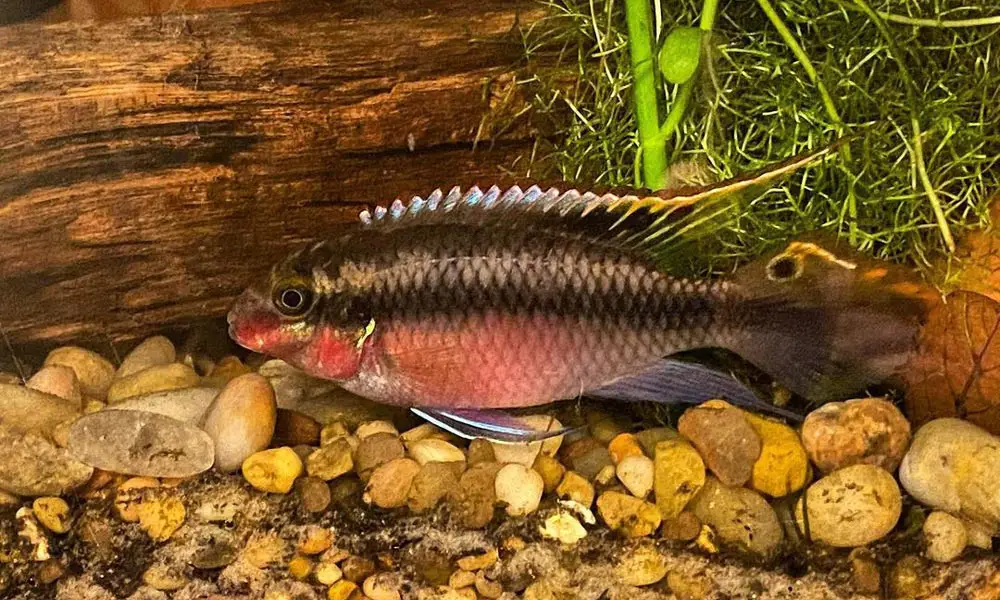
Kribs were the first West African cichlid to be popularized in the aquarium trade, and they are still one of the most popular today. They are small, only growing to about 4 inches (10 cm), and are very peaceful, making them great for community tanks.
They are considered the most beautiful belly fish, with females developing the characteristic cherry-red coloration. Additionally, they come in a wide range of colors, and the most sought after in the hobby are these red and yellow variants.
| Scientific Name: | Pelvicachromis pulcher |
| Common Name: | krib, Common krib, Red Krib, Super-red Krib, Rainbow Krib, Purple Cichlid |
| Max Size: | 4.9 inches (12.5 cm) |
| Diet: | Omnivore |
| Minimum Tank Size: | 20 Gallons |
Pseudocrenilabrus nicholsi (Nichols’ Dwarf Mouthbrooder)
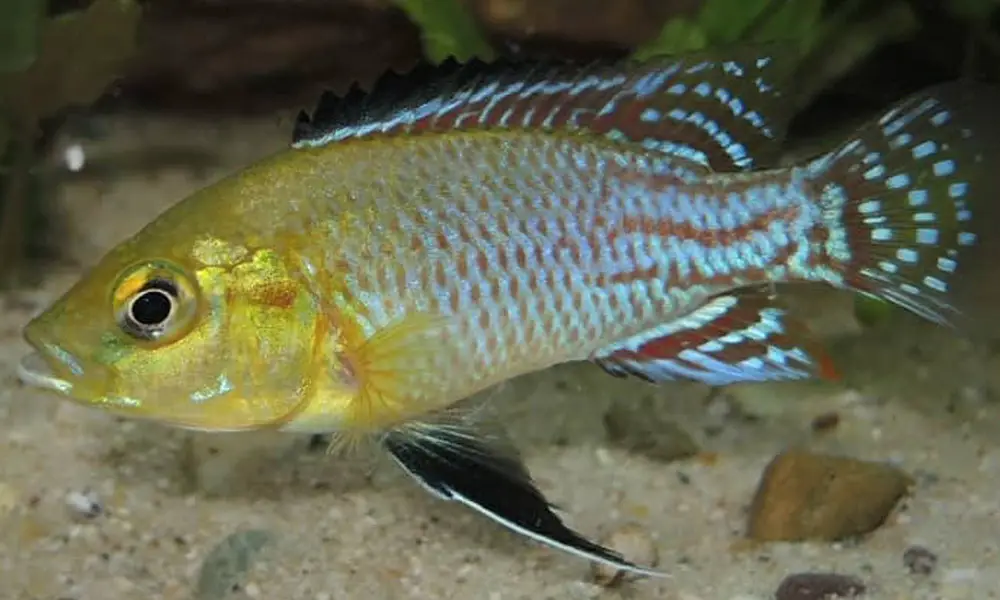
Pseudocrenilabrus nicholsi (Nichols’ Mouthbrooder) is a wonderful ray-finned fish that anyone would be lucky to have in their collection.
Although they are referred to as dwarf cichlid due to their small size, technically speaking, they are not.
Males of this species take on blueish-purple coloration with red lines. Beyond their base color, they have light yellow faces and metallic blue lips. Females are much subdued even though they have similar patterns.
| Scientific Name: | Pseudocrenilabrus nicholsi |
| Common Name: | Nichols’ Mouthbrooder |
| Max Size: | Males: 4 inches, Females: 2.5 inches |
| Diet: | Omnivore |
| Minimum Tank Size: | 40 Gallons Long |
Hemichromis bimaculatus (Jewel Cichlid)
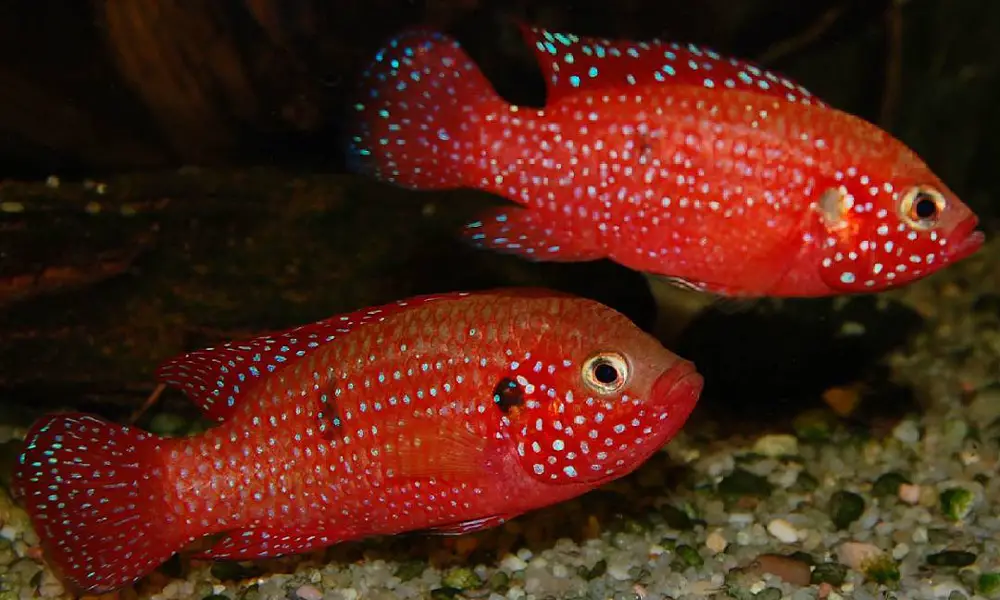
The Jewel cichlid is a colorful fish that we recommend to any West African cichlid lover all the time due to its beautiful colors.
These fish are aptly named after the red body that is covered with “jewel-like” blue spots and three distinct black dots. Males exhibit this blue patterning in reticular.
Unfortunately, these fish are unsuitable for community aquariums due to their high aggressive territorial levels, especially when breeding.
| Scientific Name: | Hemichromis bimaculatus |
| Common Name: | Jewel Cichlid |
| Max Size: | 6 inches (15cm) |
| Diet: | Omnivore |
| Minimum Tank Size: | 30 Gallons |
Hemichromis exsul (Turkana Jewel Cichlid)

The Turkana Jewel Cichlid (Hemichromis exsul) is a beautiful, uncommon species that belongs to the small genus Hemichromis. It currently has 13 species; H. exsul is one of the smaller and less aggressive members, making them more commonly available in the trade.
This species falls somewhere at the top of the spectrum when it comes to coloration and pattern. The base color is vivid blood red, with dark, blackish rims that adorn their fins.
Turkana Jewel Cichlids can be hard to find in the trade because it’s forbidden to export them from Kenya. So good luck!
| Scientific Name: | Hemichromis exsul |
| Common Name: | Turkana Jewel Cichlid |
| Max Size: | 4 inches (11.4 cm) |
| Diet: | Omnivore |
| Minimum Tank Size: | 30 Gallons |
Nanochromis transvestitus (West African Dwarf Cichlid)

N. transvestitus is a rare, stunning dwarf cichlid from West Africa. Interestingly, unlike most other African Cichlids – the males are the more colorful sex. This fish is an exception, with the females being much more colorful.
Both males and females take on an oval-like shaped brown body with brighter brown vertical stripes that extend into the dorsal fin.
Males grow slightly larger, and their bodies are more elongated. However, the females have a bright reddish-pink belly and spot an alternating black and white tail fin. You may also find these exciting patterning on the edges of its dorsal and anal fin.
It’s worth noting that the extreme aggression levels of the dominant males make it challenging to keep in the home aquarium and are best suited for advanced hobbyists.
| Scientific Name: | Nanochromis transvestitus |
| Common Name: | West African Dwarf Cichlid |
| Max Size: | 1.3 inches (3.30 cm) |
| Diet: | Omnivore |
| Minimum Tank Size: | 30 Gallons |
Steatocranus casuarius (Buffalo Head Cichlid)

Looking for the unique Cichlid from West Africa? Look no further than the Buffalo Head cichlid (Steatocranus casuarius). This species is one of the most interesting-looking freshwater fish in the world and is a real head-turner in any aquarium.
The body shape of this species is what sets them apart from other cichlids. They have an elongated and laterally compressed body. The most definitive feature is a prominent forehead nuchal hump in males, even though both males and females have it to some extent.
| Scientific Name: | Steatocranus casuarius |
| Common Name: | Buffalo Head Cichlid |
| Max Size: | Males: 4.8 inches (12 cm), Females: 3 inches (8 cm) |
| Diet: | Omnivore |
| Minimum Tank Size: | 30 Gallons |
Conclusion
African cichlids are some of the most beautiful and unique fish in the world. Their bright colors and patterns are truly breathtaking, and they come in a wide variety of shapes and sizes. However, they are simply very aggressive, especially these Mbunas and Predatory “Haps.”
If you do not like aggression or are not ready for it, you should get a South American cichlid aquarium with some peaceful and adaptable SA & CA community fish. These New World Cichlids are extremely intelligent and have fascinating personalities.
But if you are looking for a challenge and want to keep an African cichlid aquarium, we hope this guide has given you some ideas and inspiration. Remember to do your research before adding any fish to your tank!
We hope this guide was helpful. If we miss some of your favorite African cichlids, please let us know in the comment section below. Until next time, happy fish keeping!
